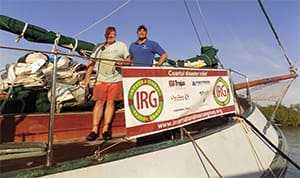As mariners, we all know the importance of a good sail on our boat. With skill and patience they can take us in any direction, to a nearby island or around the world, and give us a palpable sense of true freedom found no other way. In the slightest zephyr, they keep us ghosting along. If too rough, we reef them or heave to until conditions improve, and they can even be used to set the anchor or partially plug a hole in the hull. But in a nature-battered developing nation like Haiti, they can be the difference between life and death.
The one-two punch of the 2010 earthquake and Hurricane Matthew in October 2016 has left this impoverished island nation of 11 million in a state of severe food, water and economic insecurity. In one day, the storm destroyed 75 to 100 percent of the crops and fruit-bearing trees in the southern breadbasket, along with 80 percent of the livestock. The unemployment rate has surpassed 75 percent, and the people live on a little more than two dollars a day.
The fishermen operate like so many of the resourceful people here: They get the job done with whatever’s available and however they can, like a sequel of Hemingway’s Old Man and the Sea. Each day, they put to sea in small, often leaky, engineless boats, using sails made from whatever material is at hand — sacks of flour, shower curtains or bedsheets — attempting to catch enough fish to feed their families and earn a few extra gourdes with the surplus.
And so many are counting on what they do. The food stocks and fresh water have diminished to a level that has made the seafood industry of critical importance. In the Tiburon Peninsula, which the eye of Matthew traveled over, an outbreak of cholera made things so bad that people were abandoning their villages to search for food and clean water. The international community is helping, but many key roads and bridges have been washed out, making it difficult to get aid evenly distributed.
Enter avid sailors Michael Laas and Michael Carcaise. As University of Miami college students, they visited Haiti to gather data for an engineering project and met with Peace Corp volunteers who also sailed. After witnessing some Haitian fishermen setting up their boats, they had an “a-ha moment” and Sails for Sustenance was born.
The concept was brilliantly simple: Through yacht clubs, regattas and boat shows, the two Michaels got the word out that those old sails in the garage or attic could now be donated to Haitian fishermen who would re-cut them and put them to use on their boats. Not only would the donors be doing something good, they would get a tax deduction too!
“These sails are a huge improvement, enabling the fishermen to sail more safely at higher speeds,” beamed Michael Laas. “And it takes them off the near-shore reef, which is very depleted and into deeper water, so they can spread out their impact over a larger area of ocean.
“Our overall goal is to have a positive impact on coastal Haitian communities and the lives of fishermen, and at the same time bringing the U.S. sailing community closer to the people that still live off the sea. We also did research to determine that we weren’t putting anyone out of business.”
To date, Sails For Sustenance has shipped several tons of sails via partnerships with other nonprofit organizations. In December they shipped 43 sails and life jackets aboard International Relief Group’s 97-foot gaff-rigged ketch Thunderbird V on a relief voyage to Île-à-Vache. They will offload the relief goods and then begin dispensing potable water via their onboard desalinator.
To see Haitian fishermen in action or to donate your used sails, go to sailsforsustenance.org.

